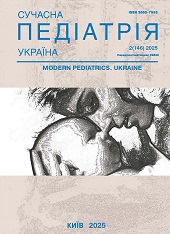Sensitive skin syndrome in children
DOI:
https://doi.org/10.15574/SP.2025.2(146).96103Keywords:
sensitive skin syndrome, sensitive skin, hypersensitive skin, reactive skin, hyperreactive skin, highly reactive skin, intolerant skin, irritable skin, childrenAbstract
Sensitive skin syndrome in children is an extremely relevant problem in our time, which is being intensively studied all over the world. According to known scientific data, more than half of the world's population has sensitive skin, which significantly worsens the quality of life of patients.
Aim - to increase awareness about sensitive skin syndrome in children, classification, modern diagnostic methods, clinical features and treatment of sensitive skin in children.
Sensitive skin syndrome is a combination of subjective (pain, hyperesthesia, tingling, burning, itching, tightness) and objective clinical symptoms (erythema, reactive transient hyperemia, dryness, peeling, increased skin pattern, tendency to telangiectasia). Sensitive skin syndrome in children can be characterized as reduced resistance or increased reactivity of the skin in response to common exogenous and/or endogenous factors that cannot be considered as common irritants. The formation of sensitive skin syndrome in children is influenced by many factors: age, gender, skin phototype, structural changes in the skin caused by genetic and constitutional factors, hormones, physiological irritants, weather, climatic and environmental factors, lifestyle, and concomitant dermatological diseases. The variety of known modern classifications of sensitive skin types reflects the lack of a unified position among dermatologists on this issue. A significant number of invasive and non-invasive tests have been proposed by scientists to assess and predict sensitive skin in children. Modern recommendations for caring for sensitive skin in children are focused on the following areas: avoiding provoking irritants, restoring the skin barrier, regulating the epidermal microbiome, and calming neuroinflammation.
Conclusions. Sensitive skin syndrome in children is a universal phenomenon in a modernized society with widespread use of cosmetics and personal care products. Knowledge of possible exogenous and endogenous irritants to sensitive skin will allow for the targeted development of personalized recommendations for the care of sensitive skin in children. Screening and timely diagnostic, proper care, and treatment of sensitive skin syndrome in children can improve health and enhance quality of life.
The authors declare no conflict of interest.
References
Boyarchuk O, Mochulska O, Komorovsky R. (2021). Diagnosis and management of pharyngitis in children: a survey study in Ukraine. GERMS. 11(3): 363-371. https://doi.org/10.18683/germs.2021.1273; PMid:34722358 PMCid:PMC8548041
Boyer G, De Belilovsky C, Brédif S, Baudouin C, Misery L, Bellemère G. (2021). Clinical and Instrumental Exploration of Sensitive Skin in a Pediatric Population. Cosmetics. 8: 43. https://doi.org/10.3390/cosmetics8020043
Diehl C. (2018). The burden of sensitive skin. Ukrainian Journal of Dermatology, Venereology, and Cosmetology. 2(69): 86-92. https://doi.org/10.30978/UJDVK2018-2-86
Guerra-Tapia A, Serra-Baldrich E, Prieto Cabezas L, González-Guerra E, López-Estebaranz JL. (2019). Diagnosis and Treatment of Sensitive Skin Syndrome: An Algorithm for Clinical Practice, Actas Dermo-Sifiliográficas (English Edition). 110(10): 800-808. https://doi.org/10.1016/j.adengl.2019.10.004
Inamadar AC, Palit A. (2013). Sensitive skin: An overview. Indian Journal of Dermatology, Venereology and Leprology. 79: 9-16. https://doi.org/10.4103/0378-6323.104664; PMid:23254724
Jiang Сh, Guo Ch, Yan J, Chen J, Peng Sh, Huang H et al. (2024). Sensitive skin syndrome: Research progress on mechanisms and applications. Journal of Dermatologic Science and Cosmetic Technology. 1(2): 100015. https://doi.org/10.1016/j.jdsct.2024.100015
Kam Tim Michael Chan. (2018). Clinical Review on Sensitive Skin: History, Epidemiology, Pathogenesis and Management. Journal of Clinical & Experimental Dermatology Research. 9(4): 1000453. https://doi.org/10.4172/2155-9554.1000453
Misery L, Ständer S, Szepietowski JC, Reich A, Wallengren J, Evers AW et al. (2017). Definition of Sensitive Skin: An Expert Position Paper from the Special Interest Group on Sensitive Skin of the International Forum for the Study of Itch. Acta Dermato-Venereologica. 97: 4-6. https://doi.org/10.2340/00015555-2397; PMid:26939643
Misery L, Taïeb C, Brenaut E, Huet F, Abasq-Thomas C et al. (2020). Sensitive Skin in Children. Acta Dermato-Venereologica. 100: adv00039. https://doi.org/10.2340/00015555-3376; PMid:31742650 PMCid:PMC9128939
Misery L, Weisshaar E, Brenaut E, Evers AWM, Huet F, Stander S et al. (2020). Pathophysiology and management of sensitive skin: position paper from the special interest group on sensitive skin of the International Forum for the Study of Itch (IFSI). Journal of the European Academy of Dermatology and Venereology. 34: 222-229. https://doi.org/10.1111/jdv.16000; PMid:31660659
Mochulska OM. (2020). External therapy of allergic dermatoses in children (literature review). Ukrainian Journal of Perinatology and Pediatrics. 4(84): 41-47. https://doi.org/10.15574/PP.2020.84.41
Mochulska OM, Boyarchuk OR, Kinash MI, Shulhai OM, Dobrovolska LI. (2022). Vitamin status as an assessment of vitamins A, E, D providing in children with allergic dermatosis. Modern pediatrics.Ukraine. 6(126): 55-61. https://doi.org/10.15574/SP.2022.126.55
Mochulska OM, Boyarchuk OR, Kinash MI, Vorontsova TO, Volyanska LA. (2021). Effects of vitamins A, E, D, disorders of their metabolism and assessment of vitamin levels in children. Modern pediatrics. Ukraine. 2(114): 58-66. https://doi.org/10.15574/SP.2021.114.58
Mochulska OM, Kosovska TM. (2020). Clinical and paraclinical features of course of allergic dermatosis in children. Modern Pediatrics. Ukraine. 8(112): 33-39. https://doi.org/10.15574/SP.2020.112.33
Sukma PMG, Budianti WK, Chairunnisa S, Astriningrum R. (2022). Sensitive skin: a new entity perspective. Berkala Kedokteran. 18(2): 101-1100. https://doi.org/10.20527/jbk.v18i1.12850
Wollenberg A, Gimenez-Arnau A. (2022). Sensitive skin: A relevant syndrome, be aware. Journal of the European Academy of Dermatology and Venereology. 36(5): 3-5. https://doi.org/10.1111/jdv.17903; PMid:35315153
Downloads
Published
Issue
Section
License
Copyright (c) 2025 Modern pediatrics. Ukraine

This work is licensed under a Creative Commons Attribution-NonCommercial 4.0 International License.
The policy of the Journal “MODERN PEDIATRICS. UKRAINE” is compatible with the vast majority of funders' of open access and self-archiving policies. The journal provides immediate open access route being convinced that everyone – not only scientists - can benefit from research results, and publishes articles exclusively under open access distribution, with a Creative Commons Attribution-Noncommercial 4.0 international license (СС BY-NC).
Authors transfer the copyright to the Journal “MODERN PEDIATRICS. UKRAINE” when the manuscript is accepted for publication. Authors declare that this manuscript has not been published nor is under simultaneous consideration for publication elsewhere. After publication, the articles become freely available on-line to the public.
Readers have the right to use, distribute, and reproduce articles in any medium, provided the articles and the journal are properly cited.
The use of published materials for commercial purposes is strongly prohibited.

